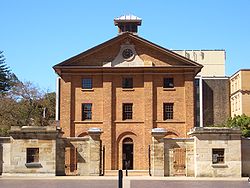| min Park Barracks, Sydney | |
|---|---|
 Hyde Park Barracks, Sydney | |
| Location | Macquarie Street, Sydney, City of Sydney, New South Wales, Australia |
| Coordinates | 33°52′09″S 151°12′46″E / 33.8693°S 151.2128°E[1] |
| Built | 1811–1819 |
| Architect | Francis Greenway |
| Owner | Sydney Living Museums |
 | |
| Type | Historic building |
| Area | 2.16 hectares (5.3 acres)[1] |
| Status | Open daily 10.00 am – 5.00 pm (Closed Good Friday and Christmas Day) |
| Website | Hyde Park Barracks Website |
| Type | Cultural |
| Designated | 2010 (34th session) |
| Part of | Australian Convict Sites |
| Reference no. | 1306 |
| Region | Asia-Pacific |
| Official name | Hyde Park Barracks, Macquarie St, Sydney, NSW, Australia |
| Type | Historic |
| Criteria | a., b., h. |
| Designated | 1 August 2007 |
| Reference no. | 105935 |
| Place File No. | 1/12/036/0105 |
| Official name | Mint Building and Hyde Park Barracks Group; Rum Hospital; Royal Mint – Sydney Branch; Sydney Infirmary and Dispensary; Queen's Square Courts; Queen's Square |
| Type | State heritage (complex / group) |
| Criteria | a., c., d., e., f. |
| Designated | 2 April 1999 |
| Part of | Mint Building and Hyde Park Barracks Group |
| Reference no. | 190 |
| Type | Other – Government & Administration |
| Category | Government and Administration |
| Builders | Francis Greenway |
|
Preview warning: Page using Template:Infobox designation list with unknown parameter "desig_criteria" | |



The Hyde Park Barracks, Sydney is a heritage-listed former barracks, hospital, convict accommodation, mint and courthouse and now museum and café located at Macquarie Street in the Sydney central business district, in the City of Sydney local government area of New South Wales, Australia. Originally constructed between 1817 and 1819 as a brick building and compound to house convict men and boys, it was designed by convict architect Francis Greenway.[2] It is also known as the Mint Building and Hyde Park Barracks Group and Rum Hospital; Royal Mint – Sydney Branch; Sydney Infirmary and Dispensary; Queen's Square Courts; Queen's Square. The site is managed by the Museums of History New South Wales, an agency of the Government of New South Wales, as a living history museum open to the public.
The site is inscribed on the UNESCO World Heritage List as one of 11 pre-eminent Australian Convict Sites[3] as among "the best surviving examples of large-scale convict transportation and the colonial expansion of European powers through the presence and labour of convicts",[4][5] and was listed on the Australian National Heritage List on 1 August 2007,[6] and on the New South Wales State Heritage Register on 2 April 1999.[7]
The historic site was closed in January 2019 for $18 million restoration work to transform it into "a rich new, immersive visitor experience like no other in Australia"[8] and reopened in February 2020.[9] Today the museum tells the stories of the thousands of men, women and children held or housed there, and the Aboriginal communities profoundly impacted by colonial expansion.[10]
- ^ a b Chapter 1 of Australian Government's "Australian Convict Sites" World Heritage nomination Archived 17 March 2011 at the Wayback Machine Accessed 5 August 2010
- ^ Cite error: The named reference
:0was invoked but never defined (see the help page). - ^ "Stories and Histories". Sydney Living History Museums. Archived from the original on 22 August 2010. Retrieved 10 October 2015.
- ^ "Australian Convict Sites". World Heritage Convention. United Nations. Retrieved 10 October 2015.
- ^ "Australian Convict Sites". Department of the Environment. Australian Government. Retrieved 10 October 2015.
- ^ "Hyde Park Barracks, Macquarie St, Sydney, NSW, Australia (Place ID 105935)". Australian Heritage Database. Australian Government. 1 August 2007. Retrieved 7 December 2018.
- ^ "Mint Building and Hyde Park Barracks Group". New South Wales State Heritage Register. Department of Planning & Environment. H00190. Retrieved 13 October 2018.
 Text is licensed by State of New South Wales (Department of Planning and Environment) under CC BY 4.0 licence.
Text is licensed by State of New South Wales (Department of Planning and Environment) under CC BY 4.0 licence.
- ^ "'Work in progress': Hyde Park Barracks closes for $18 million transformation". The Sydney Morning Herald. 10 January 2019.
- ^ Dow, Steve (20 February 2020). "'Designed to wake people up': Jonathan Jones unveils major public work at Hyde Park barracks". The Guardian. Retrieved 20 February 2020.
- ^ "Hyde Park Barracks". Museums of History NSW. Retrieved 30 July 2024.
